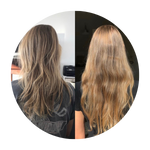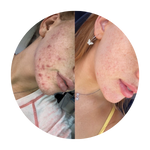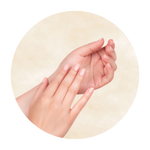Shining a Light on Female Hair Loss
When you think of hair loss, it’s common to picture a balding male. However, did you know women experience hair loss too? It's time to shine a light on this common condition that affects up to 50% of women at some point in their lives.
Female hair loss can be a distressing experience, but understanding the causes and available treatments can make a significant difference.
The Hair Growth Cycle
Hair grows in three stages:
- Anagen (Growth Phase): This is the active phase of hair growth, lasting between 2 to 8 years. At any given time, about 90% of your hair is in this phase, actively growing and gaining length.
- Catagen (Transition Phase): This short phase lasts for about 2 to 3 weeks. During this time, hair growth slows down, and hair follicles shrink, preparing to enter the resting phase.
- Telogen (Resting Phase): This final phase lasts for several months. Old hair falls out, making way for new growth to begin. It's normal to shed 50 to 100 hairs daily during this phase.
Disruptions in this cycle can lead to significant hair shedding and thinning.
Causes of Female Hair Loss
Understanding the root causes of hair loss can help in finding effective treatments. Here are some of the most common factors:
- Genetics: If you have a family history of female pattern hair loss, you are more likely to experience it yourself. This hereditary condition usually leads to thinning at the top of the head.
- Hormonal Changes: Hormones play a crucial role in hair growth. Events such as pregnancy, childbirth, menopause, and thyroid problems can cause hormonal imbalances that trigger hair loss.
- Medications: Certain medications, including those for cancer, arthritis, depression, heart problems, and high blood pressure, can have hair loss as a side effect.
- Stress: Physical or emotional stress can lead to temporary hair loss. This type of hair loss is known as telogen effluvium, where stress pushes a large number of hair follicles into the resting phase.
- Hairstyles and Treatments: Regularly wearing tight hairstyles like ponytails, braids, or buns can lead to traction alopecia, a type of hair loss caused by pulling on the hair. Chemical treatments such as dyes, perms, and relaxers can also damage hair and cause it to break.
Recognizing Hair Loss
Hair loss in women can manifest in several ways, and early detection is key to effective treatment. Here are some common signs:
- Thinning at the Top of the Head: This is the most common type of hair loss in women, known as androgenetic alopecia. It usually starts with a widening part.
- Patchy Bald Spots: Some women may experience smooth, circular bald spots on the scalp or other areas of the body.
- Sudden Hair Loosening: A physical or emotional shock can cause hair to loosen. Handfuls of hair may come out when combing or washing your hair.
- Slower Hair Growth: If you notice that your hair isn’t growing as quickly as it used to, it might be a sign of a problem.
More Than Just the Scalp
Hair loss isn't limited to the scalp. Conditions like alopecia areata can cause hair loss all over the body, including eyebrows, eyelashes, and even body hair. This autoimmune disorder causes the immune system to attack hair follicles, leading to sudden hair loss.
Underlying Health Issues
Hair loss can be a symptom of other underlying health problems. Identifying these issues is crucial for effective treatment:
- Polycystic Ovary Syndrome (PCOS): This hormonal disorder can cause hair thinning along with other symptoms like irregular periods and acne.
- Telogen Effluvium: Triggered by stress, surgery, or significant weight loss, this condition causes hair follicles to enter the resting phase prematurely.
- Thyroid Conditions: Both hypothyroidism and hyperthyroidism can cause hair loss.
- Lupus: An autoimmune disease that can cause hair loss along with fatigue, joint pain, and skin rashes.
- Nutrient Deficiencies: Essential nutrients like iron, zinc, and vitamins are vital for healthy hair. Deficiencies can weaken hair and lead to loss.
Treatment Options
While some types of hair loss may resolve on their own, others may require medical intervention. Here are some effective treatment options:
- Dietary Adjustments: Ensuring a balanced diet rich in vitamins and minerals can promote healthy hair growth. Foods high in iron, zinc, and vitamin D are particularly beneficial.
- Supplements: A targeted supplement with therapeutic doses of nutrients such as zinc and iodine can support hair health, growth, and thickness.
- Lifestyle Changes: Reducing stress through activities like yoga, meditation, and regular exercise can improve overall health and potentially reduce hair loss.
- Gentle, active topical haircare: Using natural, nutrient-rich haircare designed to support scalp health and free from chemicals can maintain an optimal scalp environment and may help support healthy hair growth cycles.
- Avoiding Harsh Treatments: Limiting the use of chemical treatments and heat styling tools can prevent further damage to your hair.
- Medications: Some cases may require medical interventions. If your health professional recommends it, there are over-the-counter treatments that can help stimulate hair growth. Prescription medications may also be available for more severe cases.
You’re Not Alone
Experiencing hair loss can impact self-confidence and emotional well-being, but it’s important to remember that you’re not alone. Many women face this challenge and find ways to manage it successfully. With the right approach and support, you can take steps to improve your hair health and regain your confidence.
References:
Cleveland Clinic, 2024. Hair loss in women. Available online. [Accessed 6th August 2024].
Birch, M.P., Lalla, S.C., Messenger, A.G. (2002). Female pattern hair loss. Clinical and Experimental Dermatology, 27(5), 396-404.
Hussein, R.S., Atia, T. and Bin Dayel, S., 2023. Impact of Thyroid Dysfunction on Hair Disorders. Monitoring Editor: Alexander Muacevic and John R Adler.
American Academy of Dermatology. (2023). Hair loss: Who gets and causes. Retrieved from AAD.





























































































